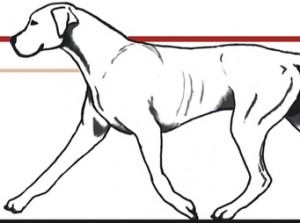Examination of Movement in Dogs – Front Assembly
74 – September, 2017
by Deborah Andoetoe
 Last month, we looked at the structure of the hindquarters in four basic designs, where very small changes in lever lengths and the resulting angles of stifle and hock provided a specific structure when viewed from the side that went on to provide predictable stride lengths. This month, we leave the hindquarters and move on to the front assembly.
Last month, we looked at the structure of the hindquarters in four basic designs, where very small changes in lever lengths and the resulting angles of stifle and hock provided a specific structure when viewed from the side that went on to provide predictable stride lengths. This month, we leave the hindquarters and move on to the front assembly.
A dog’s front limbs support his torso with a muscular sling. Muscles directly attach to bones which provide support as well as locomotion, however, they do not have a bone to bone buttress like in the hind legs (femur to pelvis to spine ). Four variations of shoulders are considered for our various breed standards. Bone length and angles of the joints all provide a distinct range of motion which, in turn, provides a distinct way of trotting when paired with the range of motion of the hindquarters.
The scapula is attached to the spinal column by four muscles. It is not fixed or stationary like the pelvis. It moves forward and backwards in relationship to the torso as the front leg is employed for movement. Because we are concerned with visualizing movement as it relates to the structure and angles of the shoulder assembly, we will not change the positioning of the scapula as it rests against the torso until we understand exactly how much a leg can move with a theoretical stationary buttress to the torso.
The shoulder blade changes shape depending on the job the dog was designed to do. Basically, it becomes wider or narrower, relative to length, to support necessary muscle structure. But, we know that every breed and size can have heavier bone or lighter bone as a natural variation. The point is to recognize expected movement for identifiable variations in structure. This will help us to both improve our dog’s performance in the ring and to produce a better dog, while also recognizing a puppy’s potential so we might choose the best structure in a litter.
We have all heard of the fabled 45o/90o shoulder angles (measured from the uppermost part of the scapula, to the point of shoulder, and to the top of the elbow). Dogs do not truly have a 45o/90o angle in their shoulder, although I have included that angle in our illustrated study so it will be easy to recognize should this fabled angulation walk into a ring. A dog who is slouching, such as a Border Collie who is herding, may exhibit something close to a shoulder angle of 45o, but a conformation judge will never see it and we cannot, realistically, train and condition dogs to stand for exam in a slouched posture without creating
Click here to read the complete article74 – September, 2017
Short URL: http://caninechronicle.com/?p=131815
Comments are closed











